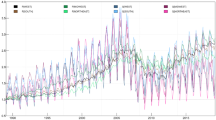Abstract
We develop a Bayesian Vector Autoregressive Model (BVAR) to forecast home sales in Connecticut. In addition to home prices and mortgage interest rates, we also include measures of current and future economic conditions to see if these variables provide useful information with which to forecast Connecticut home sales. The best performing model incorporates recently developed coincident and leading employment indexes for Connecticut. These composite indexes perform markedly better than the inclusion of individual variables such as the unemployment rate or housing permits authorized.
Similar content being viewed by others
References
Arnott, R. (1987). “Economic Theory and Housing.” In E.S. Mills (ed.), Handbook of Regional and Urban Economics, Vol. 2 (Urban Economics). Amsterdam: North-Holland Publishing, pp. 959–988.
Carroll, C. D., J. C. Fuhrer, and D. W. Wilcox. (1994).“Does Consumer Sentiment Forecast Household Spending? If So, Why?” American Economic Review 84, 1397–1408.
Cooley, T. F., and S. F. LeRoy. (1985).“Atheoretical Macroeconomics: A Critique,” Journal of Monetary Economics 16, 283–308.
Curry, D. J., S. Divakar, S. K. Mathur, and C.H. Whiteman. (1995).“BVAR as a Category Management Tool: An Illustration and Comparison with Alternative Techniques,” Journal of Forecasting 14, 181–199.
Doan, T. A. (1990). Regression Analysis of Time Series. Evanston, IL: VAR Econometrics.
Doan, T. A., R. B. Litterman, and C.A. Simms. (1984). “Forecasting and Conditional Projection Using Realistic Prior Distributions,” Econometric Reviews 3, 1–100.
Dua, P., and S. M. Miller. (1996).“Forecasting and Analyzing Economic Activity with Coincident and Leading Indexes: The Case of Connecticut.” Journal of Forecasting, in press.
Dua, P., and S. C. Ray. (1995).“A BVAR Model for the Connecticut Economy,” Journal of Forecasting 14, 167–180.
Dua, P., and D. J. Smyth. (1995). “Forecasting Home Sales Using BVAR Models and Survey Data on Households' Buying Attitudes for Homes,” Journal of Forecasting 14, 217–227.
Fuhrer, J. C. (1993).“What Role Does Consumer Sentiment Play in the US Macroeconomy?” New England Economic Review (Federal Reserve Bank of Boston)(January/February), 32–44.
Garner, A. C. (1991). “Forecasting Consumer Spending: Should Economists Pay Attention to Consumer Confidence Surveys?” Economic Review (Federal Reserve Bank of Kansas City)(May/June), 57–71.
Granger, C. W. J., and P. Newbold. (1973).“Some Comments on the Evaluation of Economic Forecasts,” Applied Economics 5, 35–47.
Hafer, R. W., and R. G. Sheehan. (1989). “The Sensitivity of VAR Forecasts to Alternative Lag Structures,” International Journal of Forecasting 5, 399–408.
Huth, W. L., D. R. Eppright, and P. M. Taube. (1994). “The Indexes of Consumer Sentiment and Confidence: Leading of Misleading Guides to Future Buyer Behavior,” Journal of Business Research 29, 199–206.
Leeper, E. M. (1992). “Consumer Attitudes: King for a Day,” Economic Review (Federal Reserve Bank of Atlanta) 77, 35–47.
Litterman, R. B. (1986). “Forecasting with Bayesian Vector Autoregressions—Five Years of Experience,” Journal of Business and Economic Statistics 4, 25–38.
Litterman, R.B. (1981). “A Bayesian Procedure for Forecasting with Vector Autoregressions.” Working paper, Federal Reserve Bank of Minneapolis.
Matsusaka, J. G., and A. M. Sbordone. (1995).“Consumer Confidence and Economic Fluctuations,” Economic Inquiry 33, 296–318.
Megbolugbe, I. F., A. P. Marks, and M. B. Schwartz. (1991). “The Economic Theory of Housing Demand: A Critical Review,” The Journal of Real Estate Research 6, 381–393.
Niemira, M. P., and P. A. Klein. (1994). Forecasting Financial and Economic Cycles. New York: John Wiley & Sons, Inc.
Schwartz, M. B. (1988). “The Estimation of Housing Demand: A Review of the Research and Its Implications.” National Association of Realtors, Forecasting and Policy Analysis Division.
Sims, C. A. (1988). “Bayesian Skepticism on Unit Root Econometrics,” Journal of Economic Dynamics and Control 12, 463–474.
Sims, C. A., J. H. Stock, and M. W. Watson. (1990). “Inference in Linear Time Series Models with Some Unit Roots,” Econometrica 58, 113–144.
Smith, L. B., K. T. Rosen, and G. Fallis. (1988). “Recent Developments in Economic Models of Housing Markets,” Journal of Economic Literature 26, 29–64.
Spencer, D. E. (1993). “Developing a Bayesian Vector Autoregression Forecasting Model,” International Journal of Forecasting 9, 407–421.
Theil, H. (1971). Principles of Econometrics. New York: John Wiley & Sons, Inc.
Throop, A. (1992). “Consumer Sentiment: Its Causes and Effects,” Economic Review (Federal Reserve Bank of San Francisco) 1, 35–56.
Todd, R. M. (1984). “Improving Economic Forecasting with Bayesian Vector Autoregression,” Quarterly Review (Federal Reserve Bank of Minneapolis) (Fall), 18–29.
United States Department of Commerce. (1977). “Composite Indexes of Leading, Coincident, and Lagging Indicators: A Brief Explanation of Their Construction.” In Handbook of Cyclical Indicators, A Supplement to the Business Conditions Digest. Washington, D.C.: Bureau of Economic Analysis, May, pp. 73–76.
United States Department of Commerce. (1984).“Composite Indexes of Leading, Coincident, and Lagging Indicators: A Brief Explanation of Their Construction.” In Handbook of Cyclical Indicators, A Supplement to the Business Conditions Digest. Washington, D.C.: Bureau of Economic Analysis, May, pp. 65–70.
Zellner, A. (1979). “Statistical Analysis of Econometric Models,” Journal of the American Statistical Association 74, 628–643.
Zellner, A., and F. Palm. (1974).“Time Series Analysis and Simultaneous Equation Econometric Models,” Journal of Econometrics 2, 17–54.
Author information
Authors and Affiliations
Rights and permissions
About this article
Cite this article
Dua, P., Miller, S.M. Forecasting Connecticut home sales in a BVAR framework using coincident and leading indexes. J Real Estate Finan Econ 13, 219–235 (1996). https://doi.org/10.1007/BF00217392
Issue Date:
DOI: https://doi.org/10.1007/BF00217392




